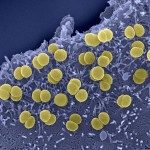Link to Pubmed [PMID] – 32032620
Link to DOI – S0163-4453(20)30060-810.1016/j.jinf.2020.01.020
J Infect 2020 May; 80(5): 519-526
The epidemiology of invasive meningococcal disease (IMD) is continuously changing in incidence, age distribution and/or the expansion of new strains of Neisseria meningitidis. The epidemiology of IMD due to group W (IMDW) has changed recently at a global level with the emergence of isolates belonging to the clonal complex ST-11 (CC11) derived from the South America-UK strain. A more recent change has been detected in France with the emergence of a new genotype distinct from CC11 that we aimed to analyse.Epidemiological and microbiological surveillance data in France were used in combination with whole genome sequencing (WGS) to detect emerging phenotypes and genotypes of IMD causing strains, and their susceptibility to immunity induced by the 4CMenB vaccine. Transgenic mice expressing the human transferrin were used to analyse the virulence of emerging strain isolates by direct comparison with CC11 isolates.Our data showed a local increase of IMDW isolates in north France since 2013. The isolates belonged to ST-9316 and few were ST-11 isolates. WGS clustered ST-9316 isolates together and were distantly separated from the isolates of the clonal complex ST-11 (CC11). Unlike cases due to W/CC11 isolates, cases due to W/ST-9316 isolates were mostly observed amongst infants under the age of 1 year but with lower mortality compared to W/CC11 cases. Genomic comparison showed that the W/ST-9316, unlike W/CC11 isolates, lacked the hmbR gene encoding the haemoglobin receptor that is a virulence factor involved in the acquisition of iron from haemoglobin. W/ST-9316 further showed lower virulence in mice compared to W/CC11 isolates.We report the emergence of a novel sequence type (ST-9316) mostly associated with serogroup W, and exhibiting a lower virulence and a distinct age specific incidence profile than W/CC11 isolates. Surveillance requires powerful approaches combining WGS and pathophysiological analysis to adapt control measures.

